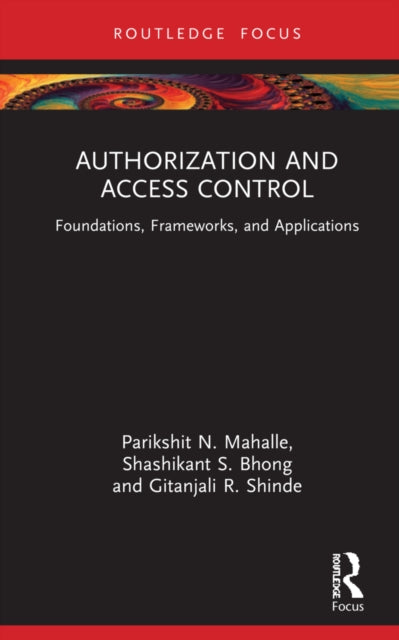Parikshit N. Mahalle,Shashikant S. Bhong,Gitanjali R. Shinde
Authorization and Access Control: Foundations, Frameworks, and Applications
Authorization and Access Control: Foundations, Frameworks, and Applications
YOU SAVE £2.50
- Condition: Brand new
- UK Delivery times: Usually arrives within 2 - 3 working days
- UK Shipping: Fee starts at £2.39. Subject to product weight & dimension
Bulk ordering. Want 15 or more copies? Get a personalised quote and bigger discounts. Learn more about bulk orders.
Couldn't load pickup availability
- More about Authorization and Access Control: Foundations, Frameworks, and Applications
The Internet of Things (IoT) presents several security challenges, including authorization and access control mechanisms, behavioural analysis of threats and attacks, and connecting web applications. To address these challenges, various mitigation techniques such as Oauth2.0 Protocol, UMA, Role-Based Access Control (RBAC), Discretionary Access Control (DAC), Mandatory Access Control (MAC), and Permission-Based Access Control (PBAC) are used. These techniques help ensure secure communication and access to IoT devices and resources.
Format: Hardback
Length: 74 pages
Publication date: 02 March 2022
Publisher: Taylor & Francis Ltd
The Internet of Things (IoT) is a rapidly growing network of devices that are connected to the internet and can communicate with each other. While this technology has many benefits, it also presents several security challenges that must be addressed. In this article, we will provide an overview of the security challenges of IoT and mitigation techniques with a focus on authorization and access control mechanisms.
Behavioural analysis of threats and attacks is an important aspect of IoT security. UML base modelling can be used to create a visual representation of the behaviour of devices and systems in the IoT. This can help identify potential vulnerabilities and weaknesses that can be exploited by attackers.
One of the most common security challenges in IoT is unauthorized access. This can be caused by weak passwords, insecure communication protocols, and lack of encryption. To mitigate this risk, authorization and access control mechanisms can be implemented.
Authorization is the process of determining who or what can access a resource or system. There are several types of authorization mechanisms, including role-based access control (RBAC), discretionary access control (DAC), mandatory access control (MAC), and permission-based access control (PBAC). RBAC is a popular approach that allows administrators to assign roles to users and devices and then control their access to resources based on those roles.
DAC is a type of authorization mechanism that allows administrators to grant or deny access to resources based on their own criteria. For example, administrators may grant access to a resource to a user who is located in a specific geographic location.
MAC is a type of authorization mechanism that requires users to authenticate themselves before they can access a resource. This can be done using a variety of methods, including passwords, biometric authentication, and smart cards.
PBAC is a type of authorization mechanism that allows administrators to grant access to resources based on the permissions that have been assigned to them. This can be useful for managing access to sensitive data.
Access control is the process of controlling who or what can access a resource or system. There are several types of access control mechanisms, including network access control (NAC), host-based access control (HBAC), and access control lists (ACLs). NAC is a network-based approach that uses policies to control access to network resources.
HBAC is a host-based approach that uses policies to control access to hosts in a network. ACLs are a list-based approach that uses policies to control access to network resources.
In addition to authorization and access control mechanisms, other security measures can be implemented to protect IoT devices and systems. These include encryption, firewalls, intrusion detection and prevention systems (IDPS), and security audits.
Encryption is the process of converting data into a code that can only be read by authorized parties. This can help protect sensitive data from being intercepted by attackers. Firewalls are a network security system that filters and monitors network traffic to prevent unauthorized access.
IDPS is a system that detects and responds to security incidents in real time. Security audits are a process of evaluating the security of a system and identifying potential vulnerabilities and weaknesses.
In conclusion, the security challenges of IoT are significant, but there are several mitigation techniques that can be implemented to protect devices and systems. Authorization and access control mechanisms are important tools that can be used to control who or what can access resources and systems in the IoT. Other security measures, such as encryption, firewalls, IDPS, and security audits, can also be implemented to enhance the security of IoT devices and systems.
Weight: 317g
Dimension: 216 x 138 (mm)
ISBN-13: 9781032214528
This item can be found in:
UK and International shipping information
UK and International shipping information
UK Delivery and returns information:
- Delivery within 2 - 3 days when ordering in the UK.
- Shipping fee for UK customers from £2.39. Fully tracked shipping service available.
- Returns policy: Return within 30 days of receipt for full refund.
International deliveries:
Shulph Ink now ships to Australia, Belgium, Canada, France, Germany, Ireland, Italy, India, Luxembourg Saudi Arabia, Singapore, Spain, Netherlands, New Zealand, United Arab Emirates, United States of America.
- Delivery times: within 5 - 10 days for international orders.
- Shipping fee: charges vary for overseas orders. Only tracked services are available for most international orders. Some countries have untracked shipping options.
- Customs charges: If ordering to addresses outside the United Kingdom, you may or may not incur additional customs and duties fees during local delivery.


